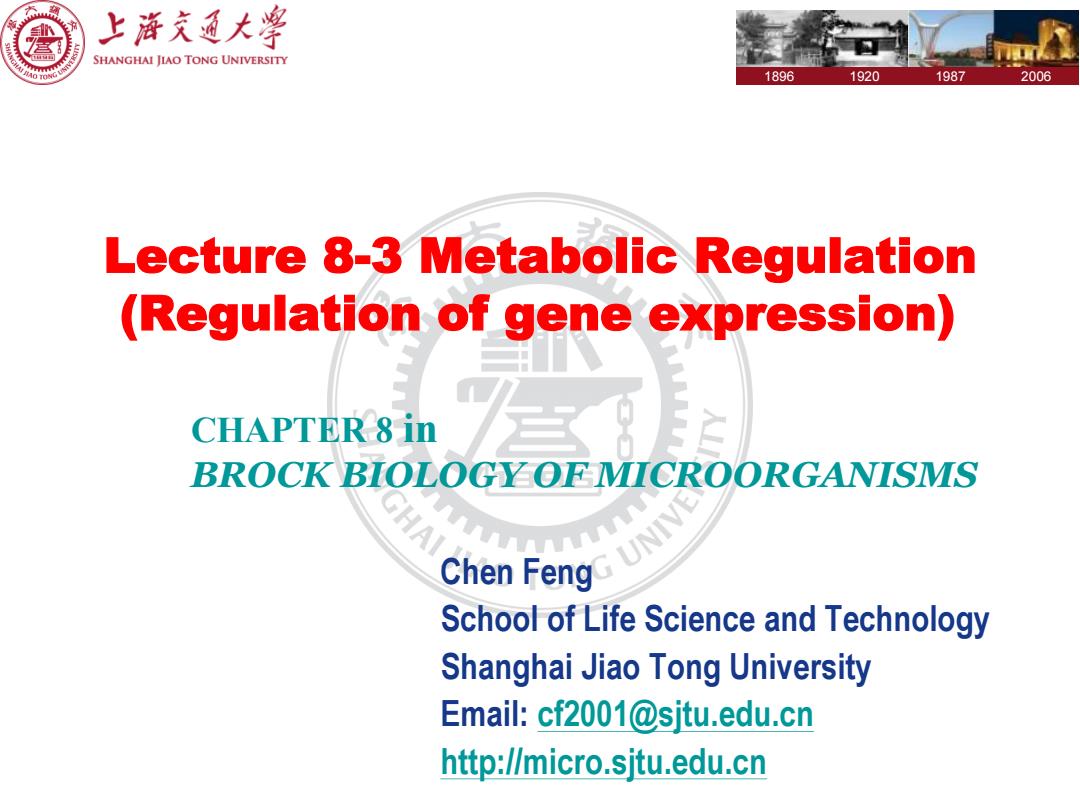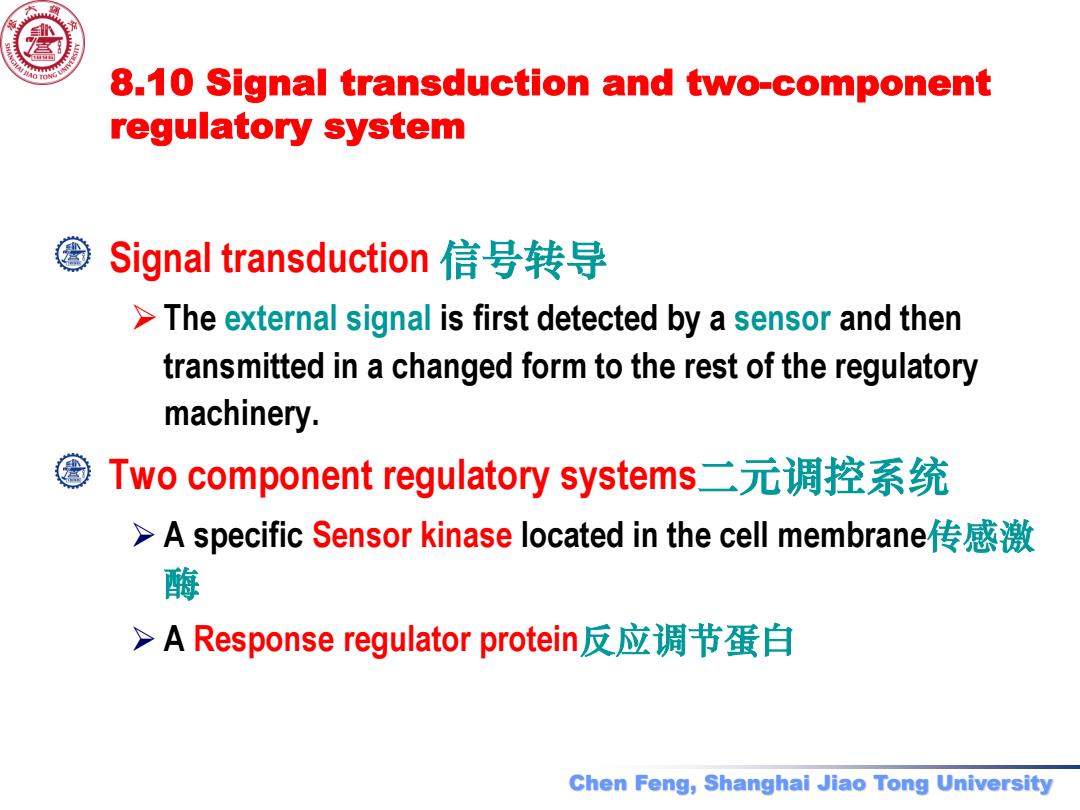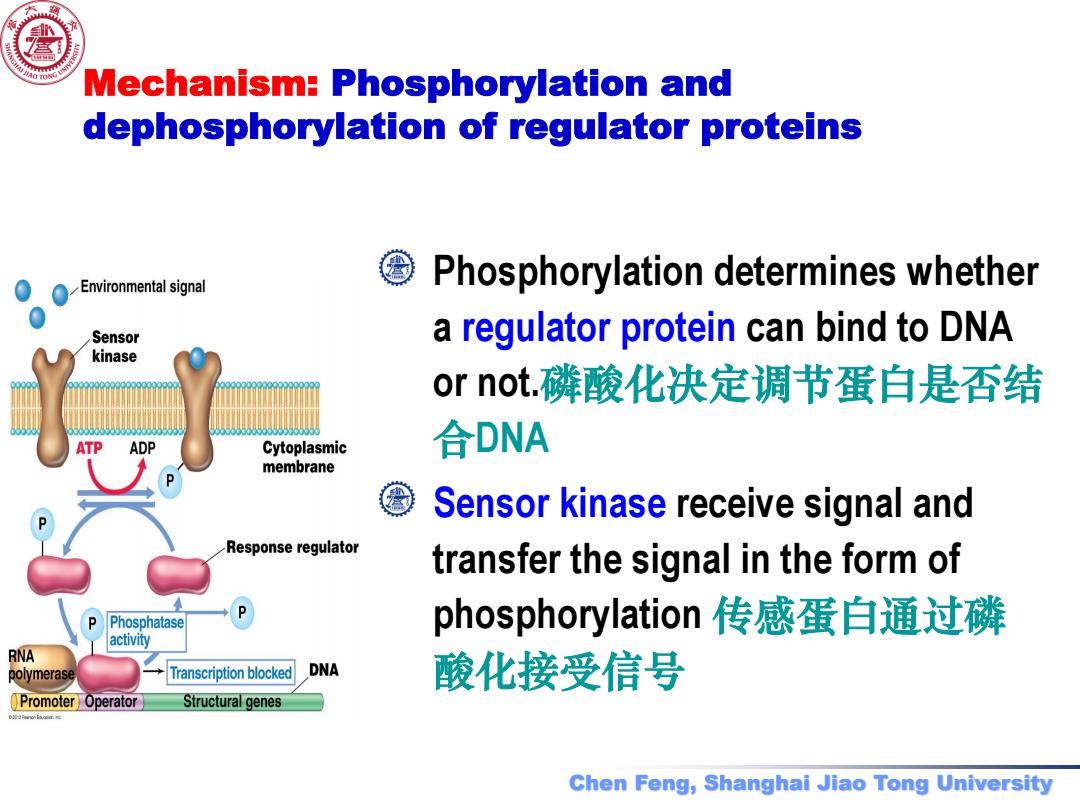
上浒充通大¥ SHANGHAI JIAO TONG UNIVERSITY 1896 1920 1987 2006 Lecture 8-3 Metabolic Regulation (Regulation of gene expression) CHAPTER 8 in BROCK BIOLOGYOFMICROORGANISMS UNI Chen Feng School of Life Science and Technology Shanghai Jiao Tong University Email:cf2001@sjtu.edu.cn http://micro.sjtu.edu.cn
1896 1920 1987 2006 Lecture 8-3 Metabolic Regulation (Regulation of gene expression) Chen Feng School of Life Science and Technology Shanghai Jiao Tong University Email: cf2001@sjtu.edu.cn http://micro.sjtu.edu.cn CHAPTER 8 in BROCK BIOLOGY OF MICROORGANISMS

8.10 Signal transduction and two-component regulatory system Signal transduction信号转导 >The external signal is first detected by a sensor and then transmitted in a changed form to the rest of the regulatory machinery. Two component regulatory systems.二元调控系统 >A specific Sensor kinase located in the cell membrane传感激 酶 >A Response regulator protein反应调节蛋白 Chen Feng,Shanghai Jiao Tong University
Chen Feng, Shanghai Jiao Tong University 8.10 Signal transduction and two-component regulatory system Signal transduction 信号转导 The external signal is first detected by a sensor and then transmitted in a changed form to the rest of the regulatory machinery. Two component regulatory systems二元调控系统 A specific Sensor kinase located in the cell membrane传感激 酶 A Response regulator protein反应调节蛋白

Mechanism of Signal Transduction Environmental signal a sensor kinase in the cell Sensor membrane phosphorylates kinase itself in response to an environmental signal. The phosphoryl group ATP ADP Cytoplasmic is then transferred to a membrane response regulator. The phosphorylated Response regulator response regulator serves as a repressor. Phosphatase activity RNA a phosphatase polymerase Transcription blocked DNA cycle the response Promoter Operator Structural genes regulator. e2的2 Pearon Eduon hg
Mechanism of Signal Transduction a sensor kinase in the cell membrane phosphorylates itself in response to an environmental signal. The phosphoryl group is then transferred to a response regulator. The phosphorylated response regulator serves as a repressor. a phosphatase cycle the response regulator

O TONG Mechanism:Phosphorylation and dephosphorylation of regulator proteins Environmental signal Phosphorylation determines whether Sensor a regulator protein can bind to dNA kinase or not..磷酸化决定调节蛋白是否结 Cytoplasmic 合DNA membrane Sensor kinase receive signal and Response regulator transfer the signal in the form of Phosphatase phosphorylation传感蛋白通过磷 activity RNA polymerase Transcription blocked DNA 酸化接受信号 Promoter Operator Structural genes Chen Feng,Shanghai Jiao Tong University
Chen Feng, Shanghai Jiao Tong University Mechanism: Phosphorylation and dephosphorylation of regulator proteins Phosphorylation determines whether a regulator protein can bind to DNA or not.磷酸化决定调节蛋白是否结 合DNA Sensor kinase receive signal and transfer the signal in the form of phosphorylation 传感蛋白通过磷 酸化接受信号

8.12 Signal Transduction:Mechanism of chemotaxis趋化性的机理:信号转导 Sensory proteins in the cell membrane细胞膜上有传 感蛋白 sense concentration changes of stimulus over time as cell moves.作用:通过时间变化来感应刺激物浓度变化. They are called methyl-accepting chemotaxis proteins (MCPs),or receptor-transducer proteins,or simply transducers.这些传感蛋白被称为甲基受体趋化蛋白 (MCP)或受体转导蛋白或转导蛋白. Chen Feng,Shanghai Jiao Tong University
Chen Feng, Shanghai Jiao Tong University 8.12 Signal Transduction: Mechanism of chemotaxis 趋化性的机理:信号转导 Sensory proteins in the cell membrane细胞膜上有传 感蛋白 • sense concentration changes of stimulus over time as cell moves.作用: 通过时间变化来感应刺激物浓度变化. • They are called methyl-accepting chemotaxis proteins (MCPs), or receptor-transducer proteins, or simply transducers. 这些传感蛋白被称为甲基受体趋化蛋白 (MCP) 或受体转导蛋白或转导蛋白